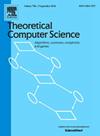On the number of equal-letter runs of the bijective Burrows-Wheeler transform
IF 0.9
4区 计算机科学
Q3 COMPUTER SCIENCE, THEORY & METHODS
引用次数: 0
Abstract
The Bijective Burrows-Wheeler Transform (BBWT) is a variant of the famous BWT [Burrows and Wheeler, 1994]. The BBWT was introduced by Gil and Scott in 2012, and is based on the extended BWT of Mantaci et al. [TCS 2007] and on the Lyndon factorization of the input string. In the original paper, the compression achieved with the BBWT was shown to be competitive with that of the BWT, and it has been gaining interest in recent years. In this work, we present the first study of the number of runs of the BBWT, which is a measure of its compression power. We exhibit an infinite family of strings on which of the string and of its reverse differ by a multiplicative factor of , where n is the length of the string. We also give several theoretical results on the BBWT, including a characterization of binary strings for which the BBWT has two runs. Finally, we present experimental results and statistics on and , as well as on the number of Lyndon factors in the Lyndon factorization of s and .
求助全文
约1分钟内获得全文
求助全文
来源期刊

Theoretical Computer Science
工程技术-计算机:理论方法
CiteScore
2.60
自引率
18.20%
发文量
471
审稿时长
12.6 months
期刊介绍:
Theoretical Computer Science is mathematical and abstract in spirit, but it derives its motivation from practical and everyday computation. Its aim is to understand the nature of computation and, as a consequence of this understanding, provide more efficient methodologies. All papers introducing or studying mathematical, logic and formal concepts and methods are welcome, provided that their motivation is clearly drawn from the field of computing.
 求助内容:
求助内容: 应助结果提醒方式:
应助结果提醒方式:


